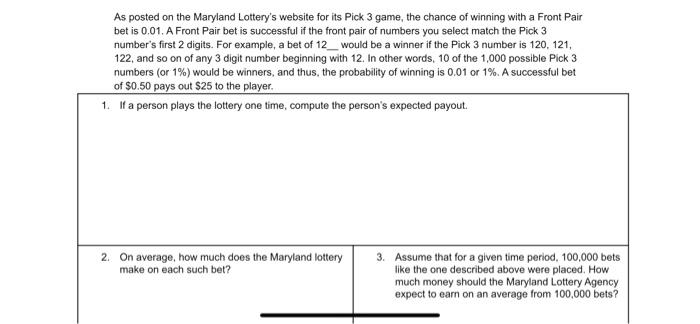please answer all questions
As posted on the Maryland Lottery's website for its Pick 3 game, the chance of winning with a Front Pair bet is 0.01. A Front Pair bet is successful if the front pair of numbers you select match the Pick 3 number's first 2 digits. For example, a bet of 12_would be a winner if the Pick 3 number is 120, 121, 122, and so on of any 3 digit number beginning with 12. In other words, 10 of the 1,000 possible Pick 3 numbers (or 1%) would be winners, and thus, the probability of winning is 0.01 or 1%. A successful bet of $0.50 pays out $25 to the player. 1. If a person plays the lottery one time, compute the person's expected payout. 2. On average, how much does the Maryland lottery make on each such bet? 3. Assume that for a given time period, 100,000 bets like the one described above were placed. How much money should the Maryland Lottery Agency expect to earn on an average from 100,000 bets? Another type of carnival or arcade game is a spinning wheel game. Imagine that someone playing a spinning wheel game earns points (payoff) as follows for each spin: You gain 2 points 50% of the time. You lose 3 points 25% of the time. You neither gain nor lose any points 25% of the time. The results of each spin are added to one another, and the object is for a player to accumulate 5 or more points. Negative total point values are possible. 4. Draw an example of a spinning wheel that would reflect the probabilities and point values. 5. Compute E(x) where x represents the number of points earned in a given spin. 6. Based on your computations, how many spins on average do you think it might take to reach 5 points? 7. Find the expected payoff of a game in which you pay $10 to play and the prizes are a giant teddy bear worth $150, a medium-sized bear worth $25, and a $10 gift certificate to the concession stand. There are 50 people playing and one of each of the prizes will be awarded. 8. A $20 bill, two S10 bills, three $5 bills, and four S1 bills are placed in a bag. If a bill is chosen at random what is the expected value for the amount chosen? If you managed this game, how much would you charge people to play? Explain your reasoning. 9. In a game of cards, you pay $1 to play. If you draw a heart, you win $3, if you draw a diamond, you win $2, if you draw a spade, you have to pay a penalty of S1, and if you draw a club, you win nothing. What is the expected payoff you win (or lose) per game? 10. You are invited to play a simple game of chance with a friend. The rules are: To play you must pay him $2. If you pick a spade from a shuffled standard deck of cards, you win $9. What is the expected payoff you could win (or lose) per game? As posted on the Maryland Lottery's website for its Pick 3 game, the chance of winning with a Front Pair bet is 0.01. A Front Pair bet is successful if the front pair of numbers you select match the Pick 3 number's first 2 digits. For example, a bet of 12_would be a winner if the Pick 3 number is 120, 121, 122, and so on of any 3 digit number beginning with 12. In other words, 10 of the 1,000 possible Pick 3 numbers (or 1%) would be winners, and thus, the probability of winning is 0.01 or 1%. A successful bet of $0.50 pays out $25 to the player. 1. If a person plays the lottery one time, compute the person's expected payout. 2. On average, how much does the Maryland lottery make on each such bet? 3. Assume that for a given time period, 100,000 bets like the one described above were placed. How much money should the Maryland Lottery Agency expect to earn on an average from 100,000 bets? Another type of carnival or arcade game is a spinning wheel game. Imagine that someone playing a spinning wheel game earns points (payoff) as follows for each spin: You gain 2 points 50% of the time. You lose 3 points 25% of the time. You neither gain nor lose any points 25% of the time. The results of each spin are added to one another, and the object is for a player to accumulate 5 or more points. Negative total point values are possible. 4. Draw an example of a spinning wheel that would reflect the probabilities and point values. 5. Compute E(x) where x represents the number of points earned in a given spin. 6. Based on your computations, how many spins on average do you think it might take to reach 5 points? 7. Find the expected payoff of a game in which you pay $10 to play and the prizes are a giant teddy bear worth $150, a medium-sized bear worth $25, and a $10 gift certificate to the concession stand. There are 50 people playing and one of each of the prizes will be awarded. 8. A $20 bill, two S10 bills, three $5 bills, and four S1 bills are placed in a bag. If a bill is chosen at random what is the expected value for the amount chosen? If you managed this game, how much would you charge people to play? Explain your reasoning. 9. In a game of cards, you pay $1 to play. If you draw a heart, you win $3, if you draw a diamond, you win $2, if you draw a spade, you have to pay a penalty of S1, and if you draw a club, you win nothing. What is the expected payoff you win (or lose) per game? 10. You are invited to play a simple game of chance with a friend. The rules are: To play you must pay him $2. If you pick a spade from a shuffled standard deck of cards, you win $9. What is the expected payoff you could win (or lose) per game










